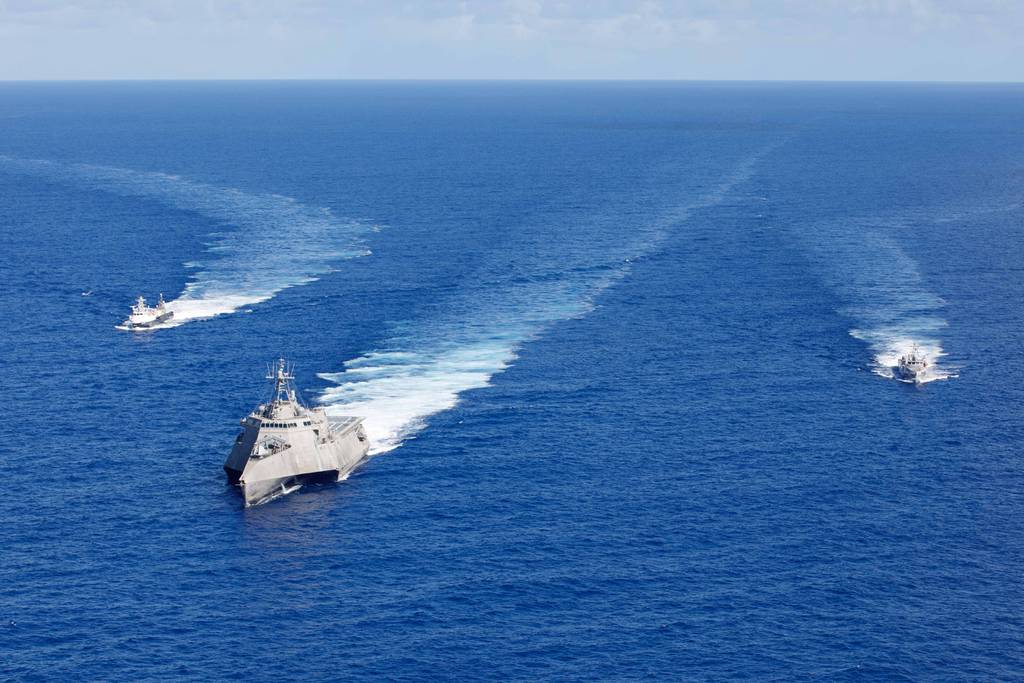
WASHINGTON — The U.S. Navy completed its first deployment of four unmanned ships, which spent five months in the Pacific testing concepts for how to integrate their capabilities into crewed fleet operations.
The unmanned surface vessels — Sea Hunter, Sea Hawk, Mariner and Ranger — departed Southern California on Aug. 7 and returned Jan. 15. The Sea Hunter and Sea Hawk originate from a Defense Advanced Research Projects Agency effort; the other two come from the Strategic Capabilities Office’s Overlord program.
During that five-month period, the four prototypes sailed a combined 46,651 nautical miles and visited ports in Japan and Australia. They also each operated for as much as 50 days at sea at a time “almost exclusively” in autonomous mode, Cmdr. Jeremiah Daley, the head of Unmanned Surface Vessel Division One, told reporters in a Tuesday call.
Daley said the deployment, overseen by U.S. Pacific Fleet, was meant to put the unmanned ships in a forward-deployed environment — with real sailors and Marines aboard operational ships — and test the existing concepts of operations, crewing assumptions, predicted maintenance needs and more.
Daley said the deployment was successful and the concepts for operations and sustainment are nearly ready for prime time. If the Navy ordered the construction of the first operational large or medium USV today, he explained, the concepts could be refined and ready to implement by the time the ship delivered to the fleet.
But there’s still more testing to do, he acknowledged.
A bright spot was command and control of the vessels.
Sea Hunter and Sea Hawk do not have accommodations for people, aside from a small bridge that’s used for controlling the vessel only while it’s entering and exiting a port.
Ranger and Mariner are optionally manned but spent the vast majority of their time on deployment in autonomous mode, Daley said.
The vessels are then controlled by staff either at the Unmanned Operations Center in Port Hueneme, California, or aboard another U.S. Navy ship in the region.
Daley said he and his division staff experimented with several ways to control the vessels from ashore and at sea, using different numbers of operators, controlling different numbers of vessels from a single console, transferring control in different ways and more — leading this to become one of the most mature aspects of the concept of operations.
But an area that requires more work is integrating the USV and its payload into the broader network of sensors and shooters. Daley declined to identify the kinds of payloads the USVs worked with, other than to say they operated in the air, on the surface and under the sea.
But their operations did highlight a need for better integration. He said merging with U.S. Indo-Pacific Command’s Joint Fires Network is one example where there’s room to “close those seams, if there are any,” to ensure data the USVs collect can be best leveraged by the rest of the Navy and joint force.
Some of that will come with the fielding of the Integrated Combat System, which the Navy is developing and is to be installed on the future Large USVs. Daley said Mariner currently runs a version of the virtualized Aegis Combat System, but the service members want more integration based on how they could conceive leveraging an unmanned ship to supplement their own operations.
Once the Integrated Combat System is complete, the same software will run on all the Navy’s crewed ships and the Large USV, allowing for the more seamless sharing of data.
While there’s still more work to do before unmanned ships become a permanent fixture in fleet operations, Daley said the excitement from the fleet was clear during the deployment — particularly from amphibious and stand-in forces looking to spread throughout the Pacific as well as both leverage and contribute to a common picture of the battlespace.
“There is a lot of synergy and energy that is all very positive in working with the combined Navy-Marine Corps team — and more importantly the stand-in force in 7th Fleet,” Daley said, referring specifically to III Marine Expeditionary Force, Task Force 76 and their integrated Navy-Marine headquarters staff in Okinawa, Japan.
“There is a lot of positive feedback and a lot of very good development into how we are going to do operations together as a stand-in force and afloat forces in 7th Fleet,” Daley said.
Megan Eckstein is the naval warfare reporter at Defense News. She has covered military news since 2009, with a focus on U.S. Navy and Marine Corps operations, acquisition programs and budgets. She has reported from four geographic fleets and is happiest when she’s filing stories from a ship. Megan is a University of Maryland alumna.
- SEO Powered Content & PR Distribution. Get Amplified Today.
- PlatoData.Network Vertical Generative Ai. Empower Yourself. Access Here.
- PlatoAiStream. Web3 Intelligence. Knowledge Amplified. Access Here.
- PlatoESG. Carbon, CleanTech, Energy, Environment, Solar, Waste Management. Access Here.
- PlatoHealth. Biotech and Clinical Trials Intelligence. Access Here.
- Source: https://www.defensenews.com/naval/2024/01/16/us-navys-four-unmanned-ships-return-from-pacific-deployment/



